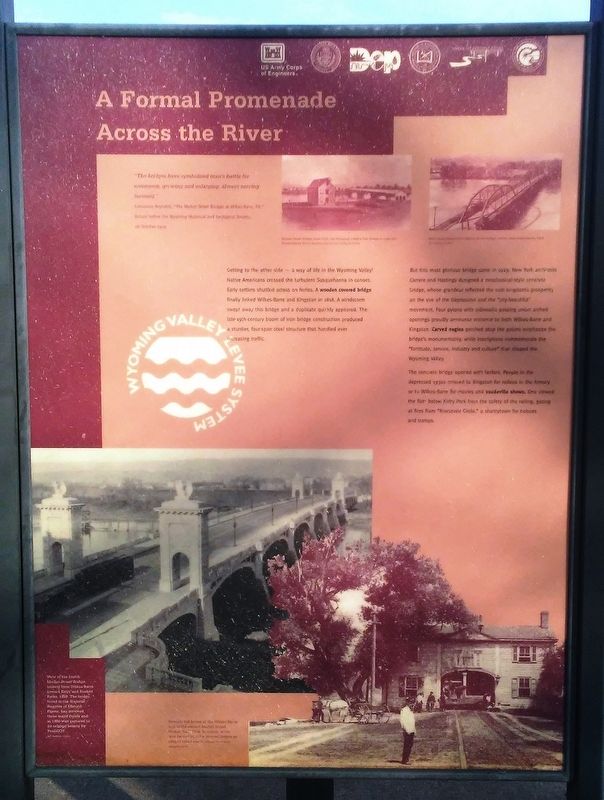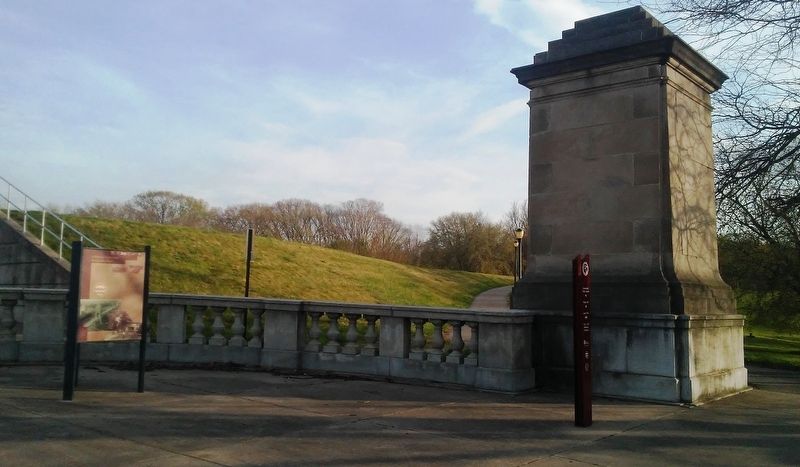A Formal Promenade Across the River
Wyoming Valley Levee System
"The bridges have symbolized man's battle for commerce, growing and enlarging, always moving forward."
Constance Reynolds, "The Market Street Bridges at Wilkes-Barre, PA," lecture before the Wyoming Historical and Geological Society, 26 October 1929
Getting to the other side — a way of life in the Wyoming Valley! Native Americans crossed the turbulent Susquehanna in canoes. Early settlers shuttled across on ferries. A wooden covered bridge finally linked Wilkes-Barre and Kingston in 1818. A windstorm swept away this bridge and a duplicate quickly appeared. The late-19th-century boom of iron bridge construction produced a sturdier, four-span steel structure that handled ever increasing traffic.
But this most glorious bridge came in 1929. New York architects Carrere and Hastings designed a neoclassical-style concrete bridge, whose grandeur reflected the coal kingdom's prosperity on the eve of the Depression and the "city-beautiful" movement. Four pylons with sidewalks passing under arched openings proudly announce entrance to both Wilkes-Barre and Kingston. Carved eagles perched atop the pylons emphasize the bridge's monumentality, while inscriptions commemorate the "fortitude, service, industry and culture" that shaped the Wyoming Valley.
The concrete bridge opened with fanfare. People in
the depressed 1930s crossed to Kingston for rodeos in the Armory or to Wilkes-Barre for movies and vaudeville shows. One viewed the flats below Kirby Park from the safety of the railing, gazing at fires from "Roosevelt Circle," a shantytown for hoboes and tramps.
[Image captions, from top to bottom, left to right, read]
• Market Street Bridge, built 1818, the Wyoming Valley's first bridge to span the Susquehanna River.
• Steel truss bridge (third Market Street Bridge) shortly after construction, 1893
• View of the fourth Market Street Bridge looking from Wilkes-Barre toward Kirby and Nesbitt Parks, 1929. The bridge, listed in the National Register of Historic Places, has survived three major floods and in 1986 was restored to its original beauty by PennDOT.
• Wooden toll house at the Wilkes-Barre end of the second Market Street Bridge, built 1824. In winter, snow was hauled into the covered bridge so sleighs could use it.
Erected by Delaware & Lehigh National Heritage Corridor and Others.
Topics. This historical marker is listed in these topic lists: Bridges & Viaducts • Man-Made Features • Waterways & Vessels. A significant historical date for this entry is October 26, 1929.
Location. 41° 15.075′ N, 75° 53.247′ W. Marker is in Kingston, Pennsylvania, in Luzerne
Other nearby markers. At least 8 other markers are within walking distance of this marker. What on Earth is a Levee? (here, next to this marker); Trailing Along (here, next to this marker); a different marker also named Trailing Along (within shouting distance of this marker); Bridging Two Cities (within shouting distance of this marker); a different marker also named What on Earth is a Levee? (within shouting distance of this marker); War Memorial (within shouting distance of this marker); Wilkes-Barre (about 600 feet away, measured in a direct line); 109th Field Artillery Battalion Memorial (approx. ¼ mile away). Touch for a list and map of all markers in Kingston.
Also see . . . Market Street Bridge, Spanning North Branch of Susquehanna River, Wilkes-Barre, Luzerne County, PA. (Submitted on May 6, 2018, by William Fischer, Jr. of Scranton, Pennsylvania.)
Credits. This page was last revised on May 6, 2018. It was originally submitted on May 6, 2018, by William Fischer, Jr. of Scranton, Pennsylvania. This page has been viewed 745 times since then and 398 times this year. Photos: 1, 2. submitted on May 6, 2018, by William Fischer, Jr. of Scranton, Pennsylvania.

